I want to use lime for several applications in the big building – plaster, mortar, to mix with clay and wood shavings for insulation, and for limewash paints. And by lime I mean non-hydraulic lime, the traditional, breathable and flexible basis of mortar and plaster used from pre-Roman times right up to the Industrial Revolution. Not to be confused with hydraulic lime, which is not so very different from Portland cement (though see comments below).
Making lime mortar and plaster from quicklime (preferable to using hydrated lime), requires a bit of forward planning. Before you can do anything with it, you first have to make lime putty, then this needs time to sit and mature for as long as possible before use. Opinions seem to vary on how long the bare minimum should be – 2 months, 3 months, 4 months – and the Romans apparently forbade the use of lime putty less than 3 years old. But there’s no disagreement about the fact that the longer it matures, the better it gets, so I wanted to get started on making the putty as soon as possible so I could give it at least 4 months. I’m kicking myself I didn’t think of this a year ago, but that’s design-it-as-you-go building for you …
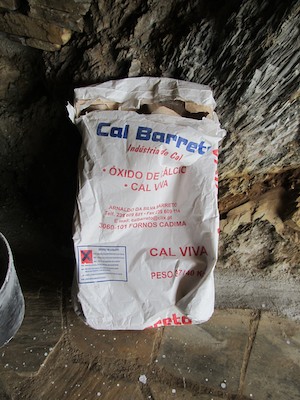
Quicklime (Calcium oxide) is readily available from builders merchants here (Cal viva), bagged and finely ground, and we were able to get an empty 200 litre (55 gallon) oil drum from the local garage from which we removed the top.

Quicklime is highly reactive, absorbing water from wherever it can find it even to the point of exploding, so it’s important to treat it with respect, wear protective gear and have a bucket of water to hand to instantly rinse any that comes in contact with skin.

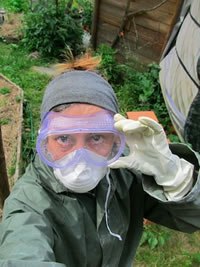
So to begin …

The oil drum cleaned and half filled with water.
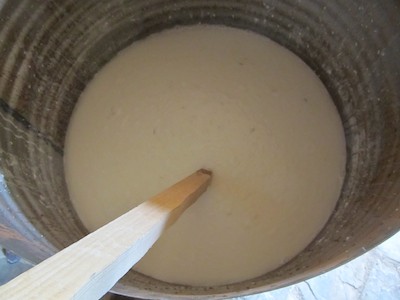
Powdered quicklime was added to the water at a rate of around 10kg a batch and stirred with a length of clean wood.

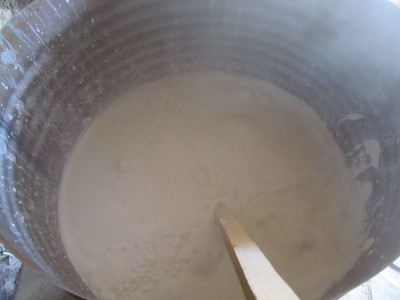
As progressively more quicklime was added, the water became hotter and hotter from the intensity of the reaction, soon boiling and giving off lots of steam.
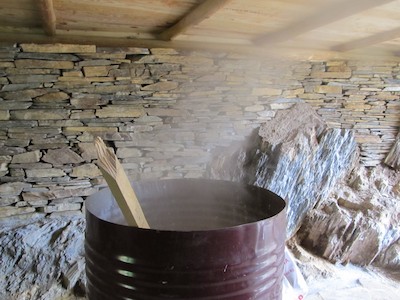
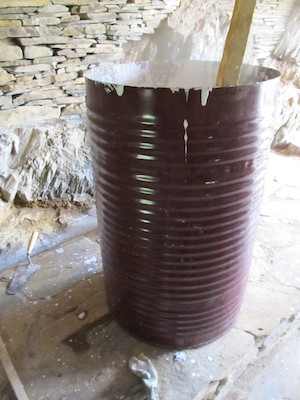
After around 50kg had been added, the reaction really took off. Almost literally. Great fun! Big kids’ chemistry set! But stand well back and keep children and animals out of range.

The result? A lovely creamy putty with the consistency of soft butter.
I slaked the remainder of the 80kg of quicklime in small batches in a metal bucket, then added this to the drum, making for a much more controlled reaction. Volcanos are fun, but only when there’s room in the container for them. We’re not ready to plaster the walls just yet.
After 24 hours the drum had cooled to body temperature and a layer of water had separated and risen to the top. Now it will sit …
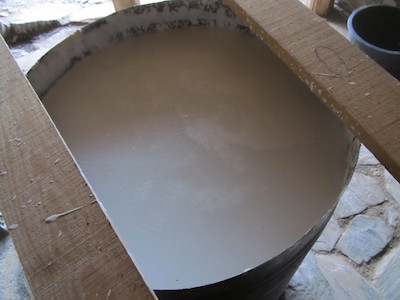
João tells me his grandmother always kept a barrel of lime on the go and that it was traditional to do so. It was also common throughout Europe to store lime putty in pits and even pass it from one generation to the next. I reckon I’ll be keeping a barrel here too.

Stuart Ogier May 30, 2012
Hiya, interesting article. NHL is nothing like cement though (it simply has naturally occuring impurities and is made in the same process as hydrated lime)… much better for outdoors applications… the romans would have used it if they had sussed out how (instead they just added crushed brick to give it hydraulic properties). I prefer putty indoors though :)
Quinta do Vale May 30, 2012
You’re right. I should have been more specific: eminently hydraulic lime (NHL 5) has properties close to that of Portland cement. The weaker hydraulic limes less so.
Lime is a contentious subject it seems! Especially when it comes to hydraulic limes … To quote Jane Schofield on the subject:
“Hydraulic lime is a blanket term for a range of materials with widely ranging properties … In the light of the current arguments about the merits of hydraulic limes, and in view of the paucity of hard facts about their performance under present conditions and in the long term, it would be very difficult to give dogmatic advice about their use.”
As for the Romans though, it seems they had pretty well developed knowledge in the use of hydraulic limes …
“It is uncertain where it was first discovered that a combination of hydrated non-hydraulic lime and a pozzolan produces a hydraulic mixture (see also: Pozzolanic reaction), but concrete made from such mixtures was first used by the Ancient Macedonians[1][2] and three centuries later on a large scale by Roman engineers.[3] They used both natural pozzolans (trass or pumice) and artificial pozzolans (ground brick or pottery) in these concretes. Many excellent examples of structures made from these concretes are still standing, notably the huge monolithic dome of the Pantheon in Rome and the massive Baths of Caracalla.[4] The vast system of Roman aqueducts also made extensive use of hydraulic cement.[5]”
Judging by the longevity of their buildings, I’d guess we’ve a lot to learn from them yet!
Luise May 30, 2012
Thanks for the great post and reminder to have a barrel ready! :) I remember an old bathtub next to my grandfather’s farmhouse (I was maybe five and both farm and land have unfortunately been long sold) filled with white stuff that everybody told me to stay away from – I vividly remember the gruesome tales of what would happen to my skin if I touched it. Much later I realized that it was lime putty.
I’m wondering though, after it has been seasoned, is it still as alkaline, do you still have to wear all that protective gear and keep your handy water bucket ready, or does it become more neutral/safe? I remember hearing somebody getting pretty “burnt” from liming his house, so I was wondering if maybe he just hadn’t seasoned it long enough?
Also, just for my better understanding, isn’t hydrated lime just quicklime that has reacted with water? Doesn’t that just shorten the process of seasoning it?
Have a great day and enjoy those cherries while they last! ;)
Luise
Quinta do Vale May 30, 2012
Calcium hydroxide (slaked lime) is still alkaline and caustic so yes, protective gear is sensible even for working with thin limewash. Hydrated lime is quicklime that’s reacted with a fixed amount of water. All the water is used up in the reaction CaO + H2O -> Ca(OH)2 and you end up with a dry powder rather than a putty which is what you get when an excess of water is used. Since no more water is available to it, it can’t mature any. For the rest, I’ll quote Jane Schofield again …
“Although [hydrated lime] has some uses, and is better than no lime at all, it is inferior to properly made lime putty for various reasons ranging from its particle size (lime putty is much finer) to its fast degradation in less than ideal storage conditions, where it can actually have carbonated in the bag. Just as you wouldn’t grind up an old bag of cement and expect it to set, it is unreasonable to expect lime mortar to work effectively if its setting properties are exhausted before it is used.”
OK … away to pick cherries …
Luise May 31, 2012
Ah, thanks! Yes, quicklime definitely sounds superior!
Is it safe to keep your lime putty in a barrel or will it corrode the metal?
Quinta do Vale May 31, 2012
As far as I’m aware from dimly remembered chemistry, iron doesn’t react with calcium hydroxide.
Luise May 31, 2012
Great! Then I’ll get me a barrel of putty as soon as we have moved… :)
Quinta do Vale May 31, 2012
:-) You can store it in plastic barrels too. Though you have to slake it in something heat resistant first.
Just saw your blog for the first time. Great stuff!
Pendle June 18, 2012
Maybe better to have an empty washing up liquid bottle full of vinegar for any spillages on skin?
Quinta do Vale June 18, 2012
Yes. Great advice. Though I’d still have the water on hand too. My instinct would be to use that first, followed by the vinegar. I always use vinegar when washing my hands after working with lime or cement anyway. Works wonders.
Ivan December 28, 2014
Great post. Question, how bad would it be for slaked lime that is still maturing to freeze? Would it just have to be remixed later?
Quinta do Vale December 28, 2014
I’ve no personal experience of lime putty freezing as it doesn’t get cold enough here for that to happen. I found this article about frozen lime putty – looks very interesting!
Yo December 13, 2015
Above link = broken pictures
(mouse over above comment “this article” to find link… about frozen lime putty)
a comment when it’s fixed would be appreciated and sent to nowisthetime@riseup.net
Quinta do Vale December 13, 2015 — Post author
I’m not responsible for other people’s websites! I suggest you contact the admins of http://www.preservationscience.com.
Jack May 21, 2017
Will I get Lime Putty if I mix my Builders Lime (Hydrated lime) in a barrel of water? It seems unclear as to the answer,
Quicklime is NOT available here.
Quinta do Vale May 21, 2017 — Post author
You’ll get a form of lime putty, yes, but it won’t have the properties of lime putty made from quicklime (calcium oxide). Lime putty made from quicklime reacts exothermically with water to produce calcium hydroxide. Some of the skill involved in the slaking process is in making sure you don’t ‘drown’ the lime which happens when the reaction doesn’t heat up enough because there’s too much water. You still end up with a calcium hydroxide gel/putty, but it doesn’t have the same strength, integrity, and structural properties.
Hydrated lime is partially-slaked quicklime which is then kiln-dried and crushed to a powder, so is a mixture of calcium hydroxide and calcium oxide. When you add water, the reaction is much milder, because a lot of it has already been turned to calcium hydroxide. You still end up with the calcium hydroxide gel/putty at the end, but I guess it’s a bit like drowned lime. Hydrated lime evolved as a way of speeding up the process of lime putty making (as well as making it safer), and like most things done to speed processes up, the end result is inferior.
You don’t say where you are, but ‘lime’ is very variable in how it’s made and sold depending on the country you’re in. Being as it’s derived from limestone, which naturally varies enormously in purity and in the other constituents present, many countries have evolved their own classification systems according to the types of lime present in the region. The one in the USA, for instance, is different from the ones in Europe. If you can’t get quicklime where you are, then I would talk to local builders who use lime and ask about the applications you’re wanting it for.
Jack May 21, 2017
Thanks Quinta, first straight answer I found.
Builders here have no clue what lime is.
Further, In order to keep my couple of bags of Hydrated Lime from carbonising, Can I put it in the drum of water?
Quinta do Vale May 21, 2017 — Post author
I guess you could try! I honestly don’t know as I’ve no experience with hydrated lime, but being as lime putty made from quicklime gets better the longer it matures under water, I would think it’s probably better than storing the lime as powder. And who knows … it may even improve with age!
Jack May 21, 2017
Quinta – Muito Obrigado.
I had 2 bags of fresh Hydrated Lime (Mortar and plaster lime)
and went ahead and stirred it into water. There was no heat at all.
We’ll see how it works when I use it in a few months.
Quinta do souto August 18, 2022
Thx for the good post and research,
Have you found any books (other than jane schofield) on the subject?
Thanks,
Quinta do souto
Wendy Howard August 18, 2022 — Post author
I haven’t used any other books though doubtless there’s many.